Structural Diagenesis in Clay Smearing Bands Developed on Plio-Pleistocene Sediments Affected by the Baza Fault (S Spain)
Abstract
:1. Introduction
2. Geological Context and Materials
3. Methods
4. Results
4.1. Carbonate Levels
4.2. Silt Levels
- (a)
- Disaggregation bands. The sediments with coarser grains (50–200 µm) show thick bands (up to 300 µm) developing granular flow processes (grain-boundary sliding or grain rolling) (Figure 6). Mixing with sediments of smaller size is also observed at distinct bands (Figure 6a). An increase of grain angularity and a decrease of grain size occur due to local grain cracking (Figure 6b,c). Dolomite appears as cement in these bands.
- (b)
- Phyllosilicate bands. Sediments with high contents of coarse muscovite, paragonite and chlorite grains (around 30 µm) develop shear-induced rotation producing phyllosilicate alignment, which forms a special kind of disaggregation band with local fabrics, where the disposition of platy minerals favours frictional grain-boundary sliding (Figure 6d). Dolomite can be observed as cement also in these bands.
4.3. Dark Clays
5. Discussion
5.1. Mechanical Deformation
5.2. Chemical Deformation: Illitization Process
6. Conclusions
- Mineral composition of the sediment is an important factor controlling brittle or ductile mechanism of deformation in the unconsolidated sediments of the Guadix-Baza Basin (Betic Cordillera, S Spain).
- SEM and TEM images suggest that flow and local cataclasis of grains were the main mechanisms involved in the shearing processes of carbonate beds and silicate-rich layers of silts, producing deformation bands.
- The predominance of beidellitic smectite in the shear structure of the clay smearing bands produced by the phyllosilicate-rich sediments, as well as the bending of these smectites around the brittle clasts suggest a ductile behaviour of these sediments.
- Precipitation of gypsum and dolomite sealing deformation bands could indicate that fluids integrated in the sediments by deformation were of high salinity, which may be related to the lacustrine waters of the basin.
- The interaction of micromechanical processes that generated pores as pressure shadow, and the flow and concentration of saline fluids in these pores were important variables promoting the authigenesis of clays and the structural diagenesis process.
- Hypersaline-restricted sites at the pressure shadows formed during clay smearing can react with pre-existing clays, promoting fast mineral transformations that could favour K, Mg or Fe uptaking from fluids.
- A future characterization of in situ measurements of rock properties (e.g., permeability and Young’s modulus) will help to clarify the influence of mechanical deformation and the formation of authigenic clays on the variation of permeability in the Baza fault zone.
Author Contributions
Funding
Acknowledgments
Conflicts of Interest
References
- Schmatz, J.; Vrolijk, P.; Urai, J. Clay smear in normal fault zones—The effect of multilayers and clay cementation in water-saturated model experiments. J. Struct. Geol. 2010, 32, 1834–1849. [Google Scholar] [CrossRef]
- Fossen, H.; Johansen, T.E.S.; Rotevatn, A.; Hesthammer, J. Fault interaction in porous sandstones. AAPG Bull. 2005, 89, 1593–1606. [Google Scholar] [CrossRef]
- Torabi, A.; Jiménez-Millán, J.; Jiménez-Espinosa, R.; García-Tortosa, F.J.; Abad, I.; Ellingsen, T.S.S. Effect of Mineral Processes and Deformation on the Petrophysical Properties of Soft Rocks during Active Faulting. Minerals 2020, 10, 444. [Google Scholar] [CrossRef]
- Giorgetti, C.; Collettini, C.; Scuderi, M.M.; Barchi, M.R.; Tesei, T. Fault geometry and mechanics of marly carbonate multilayers: An integrated field and laboratory study from the Northern Apennines, Italy. J. Struct. Geol. 2016, 93, 1–16. [Google Scholar] [CrossRef]
- Yielding, G. Shale Gouge Ratio—Calibration by Geohistory. In Hydrocarbon Seal Quantification: Norwegian Petroleum Society Special Publication; Koeslter, A.G., Hunsdale, R., Eds.; Norwegian Petroleum Society: Oslo, Norway, 2002; Volume 11, pp. 1–15. [Google Scholar]
- Faulkner, D.R.; Rutter, E.H. The gas permeability of clay-bearing fault gouge at 20°C. Geol. Soc. Lond. Spec. Publ. 1998, 147, 147–156. [Google Scholar] [CrossRef]
- Hippler, S.J. Deformation microstructures and diagenesis in sandstone adjacent to an extensional fault: Implications for the flow and entrapment of hydrocarbons. AAPG Bull. 1993, 77, 625–637. [Google Scholar] [CrossRef]
- Farrell, N.J.C.; Debenham, N.; Wilson, L.; Wilson, M.J.; Healy, D.; King, R.C.; Holford, S.P.; Taylor, C.W. The effect of authigenic clays on fault zone permeability. J. Geophys. Res. Solid Earth 2021, 126, e2021JB022615. [Google Scholar] [CrossRef]
- Vrolijk, P.J.; Urai, J.L.; Kettermann, M. Clay smear: Review of mechanisms and applications. J. Struct. Geol. 2016, 86, 95–152. [Google Scholar] [CrossRef]
- Rutter, E.H. Pressure solution in nature, theory and experiment. J. Geol. Soc. 1983, 140, 725–740. [Google Scholar] [CrossRef]
- Knipe, R.J. Faulting processes and fault seal. In Structural and Tectonic Modelling and Its Application to Petroleum Geology: Norwegian Petroleum Society Special Publications; Larsen, R.M., Brekke, H., Larsen, B.T., Talleraas, E., Eds.; Elsevier: Amsterdam, The Netherlands, 1992; Volume 1, pp. 325–342. [Google Scholar] [CrossRef]
- Cavailhes, T.; Soliva, R.; Labaume, P.; Wibberley, C.; Sizun, J.P. Phyllosilicates formation in faults rocks: Implications for dormant fault-sealing potential and fault strength in the upper crust. Geophys. Res. Lett. Am. Geophys. Union 2013, 40, 4272–4278. [Google Scholar] [CrossRef]
- Haines, S.H.; Van Der Pluijm, B.A.; Ikari, M.J.; Saffer, D.M.; Marone, C. Clay fabric intensity in natural and artificial fault gouges: Implications for brittle fault zone processes and sedimentary basin clay fabric evolution. J. Geophys. Res. 2009, 114, B05406. [Google Scholar] [CrossRef]
- Eichhubl, P.; D’Onfro, S.; Aydin, A.; Waters, J.; McCarty, D.K. Structure, petrophysics, and diagenesis of shale entrained along a normal fault at Black Diamond Mines, California—Implications for fault seal. AAPG Bull. 2005, 89, 1113–1137. [Google Scholar] [CrossRef]
- Laubach, S.E.; Eichhubl, P.; Hilgers, C.; Lander, R.H. Structural diagenesis. J. Struct. Geol. 2010, 32, 1866–1872. [Google Scholar] [CrossRef]
- Solum, J.G.; Davatzes, N.C.; Lockner, D.A. Fault-related clay authigenesis along the Moab Fault: Implications for calculations of fault rock composition and mechanical and hydrologic fault zone properties. J. Struct. Geol. 2010, 31, 1899–1911. [Google Scholar] [CrossRef]
- Laurich, B.; Urai, J.L.; Vollmer, C.; Nussbaum, C. Deformation mechanisms and evolution of the microstructure of gouge in the Main Fault in Opalinus Clay in the Mont Terri rock laboratory (CH). Solid Earth 2018, 9, 1–24. [Google Scholar] [CrossRef]
- Clauer, N.; Techer, I.; Nussbaum, C.; Laurich, B. Geochemical signature of paleofluids in microstructures from Main Fault in the Opalinus Clay of the Mont Terri rock laboratory, Switzerland. Swiss J. Geosc. 2017, 110, 105–128. [Google Scholar] [CrossRef]
- Haines, S.H.; Marone, C.; Saffer, D. Frictional properties of low-angle normal fault gouges and implications for low angle normal fault slip. Earth Planet. Sci. Lett. 2014, 408, 57–65. [Google Scholar] [CrossRef]
- Warr, L.N.; Wojatschke, J.; Carpenter, B.M.; Marone, C.; Schleicher, A.M.; van der Pluijm, B.A. A “slice-and-view” (FIB–SEM) study of clay gouge from the SAFOD creeping section of the San Andreas Fault at 2.7 km depth. J. Struct. Geol. 2014, 69, 234–244. [Google Scholar] [CrossRef]
- Buatier, M.D.; Cavailhes, T.; Charpentier, D.; Lerat, J.; Sizun, J.P.; Labaume, P.; Gout, C. Evidence of multi-stage faulting by clay mineral analysis: Example in a normal fault zone affecting arkosic sandstones (Annot sandstones). J. Struct. Geol. 2015, 75, 101–117. [Google Scholar] [CrossRef]
- Torabi, A.; Fossen, H.; Braathen, A. Insight into petrophysical properties of deformed sandstone reservoirs. AAPG Bull. 2013, 97, 619–637. [Google Scholar] [CrossRef]
- Pei, Y.; Paton, D.A.; Knipe, R.J.; Kongyou, W. A review of fault sealing behaviour and its evaluation in siliciclastic rocks. Earth-Sci. Rev. 2015, 150, 121–138. [Google Scholar] [CrossRef]
- Orellana, L.; Giorgetti, C.; Violay, M. Contrasting mechanical and hydraulic properties of wet and dry fault zones in a proposed shale-hosted nuclear waste repository. Geophys. Res. Lett. 2019, 46, 1357–1366. [Google Scholar] [CrossRef]
- Behnsen, J.; Faulkner, D.R. The effect of mineralogy and effective normal stress on frictional strength of sheet silicates. J. Struct. Geol. 2012, 42, 49–61. [Google Scholar] [CrossRef]
- Medina-Cascales, I.; Koch, L.; Cardozo, N.; Martin-Rojas, I.; Alfaro, P.; García-Tortosa, F.J. 3D geometry and architecture of a normal fault zone in poorly lithified sediments: A trench study on a strand of the Baza Fault, central Betic Cordillera, south Spain. J. Struct. Geol. 2019, 121, 25–45. [Google Scholar] [CrossRef]
- Alfaro, P.; Delgado, J.; Sanz de Galdeano, C.; Galindo-Zaldívar, J.; García, P.A.; Lopez-Garrido, A.C.; Casado, C.L.; Marín-Lechado, C.; Gil, A.J.; Borque, M.J. The Baza Fault: A major active extensional fault in the central Betic Cordillera (south Spain). Int. J. Earth Sci. 2007, 97, 1353–1365. [Google Scholar] [CrossRef]
- García Tortosa, F.J.; Alfaro, P.; Sanz de Galdeano, C.; Galindo-Zaldívar, J. Glacis geometry as a geomorphic marker of recent tectonics: The Guadix–Baza basin (South Spain). Geomorphology 2011, 125, 517–529. [Google Scholar] [CrossRef]
- Galindo-Zaldívar, J.; Lodeiro, F.G.; Jabaloy, A. Stress and palaeostress in the Betic-Rif cordilleras (Miocene to the present). Tectonophysics 1993, 227, 105–126. [Google Scholar] [CrossRef]
- Sanz de Galdeano, C.; García, P.A.; Peláez, J.; Alfaro, P.; Azañón, J.; Galindo-Zaldívar, J.; Casado, C.L.; López-Garrido, A.; Rodríguez-Fernández, J.; Ruano, P. Main active faults in the Granada and Guadix-Baza Basins (Betic Cordillera). J. Iber. Geol. 2012, 38, 209–223. [Google Scholar] [CrossRef]
- Vera, J.A. Estudio estratigráfico de la depresión de Guadix–Baza. Bol. Geol. Min. 1970, 91, 429–462. [Google Scholar]
- Gibert, L.; Ortí, F.; Rosell, L. Plio-Pleistocene lacustrine evaporites of the Baza Basin (Betic Chain, SE Spain). Sediment. Geol. 2007, 200, 89–116. [Google Scholar] [CrossRef]
- Nieto, F.; Ortega-Huertas, M.; Peacor, D.R.; Aróstegui, J. Evolution of illite/smectite from early diagenesis through incipient metamorphism in sediments of the Basque-Cantabrian Basin. Clays Clay Miner. 1996, 44, 304–323. [Google Scholar] [CrossRef]
- Cliff, G.; Lorimer, G. The quantitative analysis of thin specimens. J. Microsc. 1975, 103, 203–207. [Google Scholar] [CrossRef]
- Moore, D.M.; Reynolds, R.C.J. X-ray Diffraction and the Identification and Analysis of Clay Minerals; Oxford University Press: New York, NY, USA, 1997; p. 378. [Google Scholar]
- Sánchez-Roa, C.; Vidal, O.; Jiménez-Millán, J.; Nieto, F.; Faulkner, D.R. Implications of sepiolite dehydration for earthquake nucleation in the Galera Fault Zone: A thermodynamic approach. Appl. Geochem. 2018, 89, 219–228. [Google Scholar] [CrossRef]
- Allen, J.R.L. Sedimentary Structures: Their Character and Physical Basis; Elsevier: New York, NY, USA, 1982; Volume II, p. 663. [Google Scholar]
- Owen, G. Deformation processes in unconsolidated sands. In Deformation of Sediments and Sedimentary Rocks; Special Publication; Jones, M.E., Preston, R.M.F., Eds.; Geological Society: London, UK, 1987; Volume 29, pp. 11–24. [Google Scholar]
- Strachan, L.J. Slump-initiated and controlled syndepositional sandstone remobilization: An example from the Namurian of County Clare, Ireland. Sedimentology 2002, 49, 25–41. [Google Scholar] [CrossRef]
- Sánchez-Roa, C.; Faulkner, D.R.; Boulton, C.; Jiménez-Millán, J.; Nieto, F. How phyllosilicate mineral structure affects fault strength in Mg-rich fault systems. Geophys. Res. Lett. 2017, 44, 5457–5467. [Google Scholar] [CrossRef]
- Rotevatn, A.; Thorsheim, E.; Bastesen, E.; Fossmark, H.S.; Torabi, A.; Sælen, G. Sequential growth of deformation bands in carbonate grainstones in the hangingwall of an active growth fault: Implications for deformation mechanisms in different tectonic regimes. J. Struct. Geol. 2016, 90, 27–47. [Google Scholar] [CrossRef]
- Torabi, A. Cataclastic bands in immature and poorly lithified sandstone, examples from Corsica, France. Tectonophysics 2014, 630, 91–102. [Google Scholar] [CrossRef]
- Rohmer, J.; Nguyen, K.; Torabi, A. Off-fault shear failure potential enhanced by high stiff/low permeable damage zone during fluid injection in porous reservoirs. Geophys. J. Int. 2015, 202, 1566–1580. [Google Scholar] [CrossRef]
- Moore, D.E.; Lockner, D.A.; Shengli, M.; Summers, R.; Byerlee, J.D. Strengths of serpentinite gouge at elevated temperatures. J. Geophys. Res. 1997, 102, 14787–14801. [Google Scholar] [CrossRef]
- Sakuma, H.; Suehara, S. Interlayer bonding energy of layered minerals: Implication for the relationship with friction coefficient. J. Geophys. Res. Solid Earth 2015, 120, 2212–2219. [Google Scholar] [CrossRef]
- Ibanez, W.D.; Kronenberg, A.K. Experimental deformation of shale: Mechanical properties and microstructural indicators of mechanisms. Int. J. Rock Mech. Min. Sci. 1993, 30, 723–734. [Google Scholar] [CrossRef]
- Mares, V.M.; Kronenberg, A.K. Experimental deformation of muscovite. J. Struct. Geol. 1993, 15, 1061–1075. [Google Scholar] [CrossRef]
- French, M.E.; Chester, F.M.; Chester, J.S. Micromechanisms of creep in clay-rich gouge from the Central Deforming Zone of the San Andreas Fault. J. Geophys. Res. Solid Earth 2015, 120, 827–849. [Google Scholar] [CrossRef]
- Kluger, M.O.; Moon, V.G.; Kreiter, S.; Lowe, D.J.; Churchman, G.J.; Hepp, D.A.; Seibel, D.; Jorat, E.; Mörz, T. A new attraction-detachment model for explaining flow sliding in clay-rich tephras. Geology 2017, 45, 131–134. [Google Scholar] [CrossRef]
- Donath, F.A. Some information squeezed out of rock. Am. Sci. 1970, 58, 54–72. [Google Scholar]
- Donath, F.A.; Fruth, L.S., Jr. Dependence of strain-rate effects on deformation mechanism and rock type. J. Geol. 1971, 79, 347–371. [Google Scholar] [CrossRef]
- Ferrill, D.A.; Morris, A.P. Fault zone deformation controlled by carbonate mechanical stratigraphy, Balcones fault system, Texas. AAPG Bull. 2008, 92, 359–380. [Google Scholar] [CrossRef]
- Sánchez-Roa, C.; Jiménez-Millán, J.; Abad, I.; Faulkner, D.R.; Nieto, F.; García-Tortosa, F.J. Fibrous clay mineral authigenesis induced by fluid-rock interaction in the Galera fault zone (Betic Cordillera, SE Spain) and its influence on fault gouge frictional properties. Appl. Clay Sci. 2016, 134, 275–288. [Google Scholar] [CrossRef]
- Alfaro, P.; Gibert, L.; Moretti, M.; García-Tortosa, F.J.; Sanz de Galdeano, C.; Galindo-Zaldívar, J.; López-Garrido, A.C. The significance of giant seismites in the Plio-Pleistocene Baza palaeo-lake (S. Spain). Terra. Nova 2010, 22, 172–179. [Google Scholar] [CrossRef]
- Van der Zee, W.; Urai, J.L.; Richard, P.D. Lateral clay injection into normal faults. GeoArabia 2003, 8, 501–522. [Google Scholar] [CrossRef]
- Van der Zee, W.; Urai, J.L. Processes of normal fault evolution in a siliciclastic sequence: A case study from Miri, Sarawak, Malaysia. J. Struct. Geol. 2005, 27, 2281–2300. [Google Scholar] [CrossRef]
- Jiménez-Millán, J.; Abad, I.; García-Tortosa, F.J.; Nieto, F.; Jiménez-Espinosa, R. Clay saline diagenesis in lake Plio-Pleistocene sediments rich in organic matter from the Guadix-Baza Basin (Betic Cordillera, SE Spain). Appl. Clay Sci. 2020, 195, 105739. [Google Scholar] [CrossRef]
- Deocampo, D.M. Authigenic clays in East Africa: Regional trends and paleolimnology at the Plio-Pleistocene boundary. Olduvai Gorge, Tanzania. J. Paleolimnol. 2004, 31, 1–9. [Google Scholar] [CrossRef]
- Deocampo, D.M. Authigenic clay minerals in lacustrine mudstones. Geol. Soc. Am. Spec. Pap. 2015, 515, SPE515-03. [Google Scholar]
- Deocampo, D.M.; Berry, P.A.; Beverly, E.J.; Ashley, G.M.; Jarrett, R.E. Whole-rock geochemistry tracks precessional control of Pleistocene lake salinity at Olduvai Gorge, Tanzania: A record of authigenic clays. Geology 2017, 45, 683–686. [Google Scholar] [CrossRef]
- Cuadros, J.; Andrade, G.; Ferreira, T.O.; de Moya Partiti, C.S.; Cohen, R.; Vidal-Torrado, P. The mangrove reactor: Fast clay transformation and potassium sink. App. Clay Sci. 2017, 140, 50–58. [Google Scholar] [CrossRef]
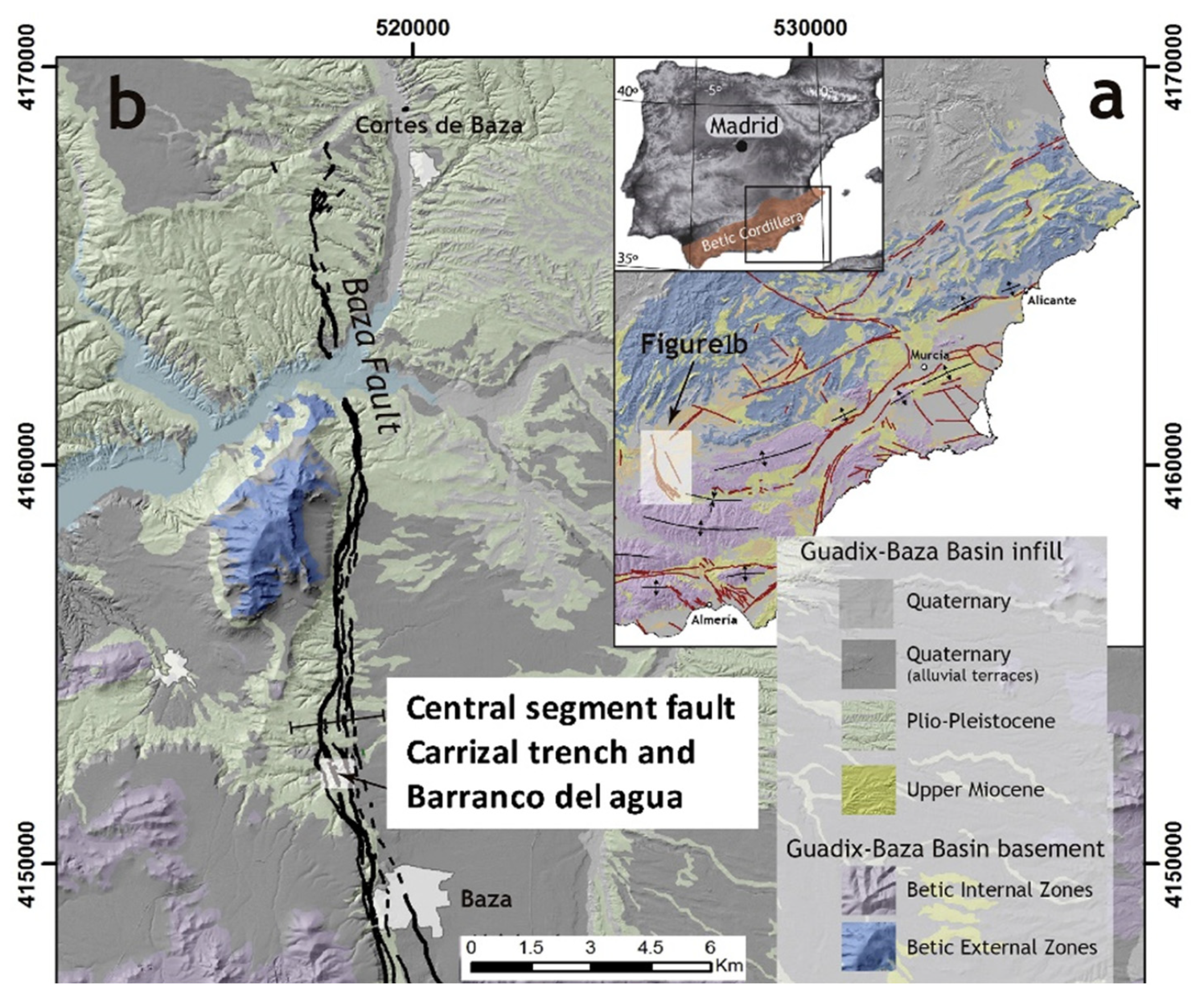
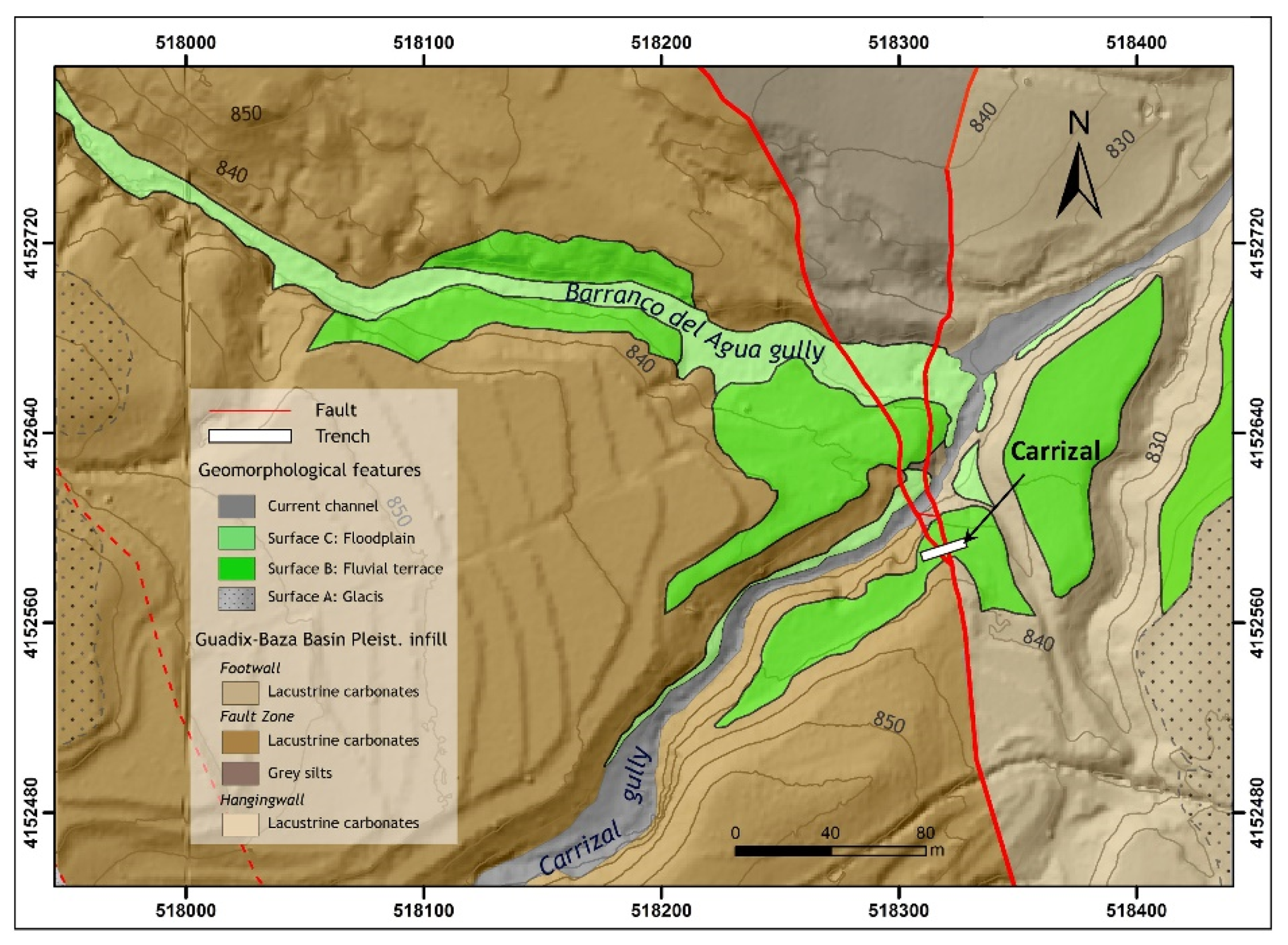
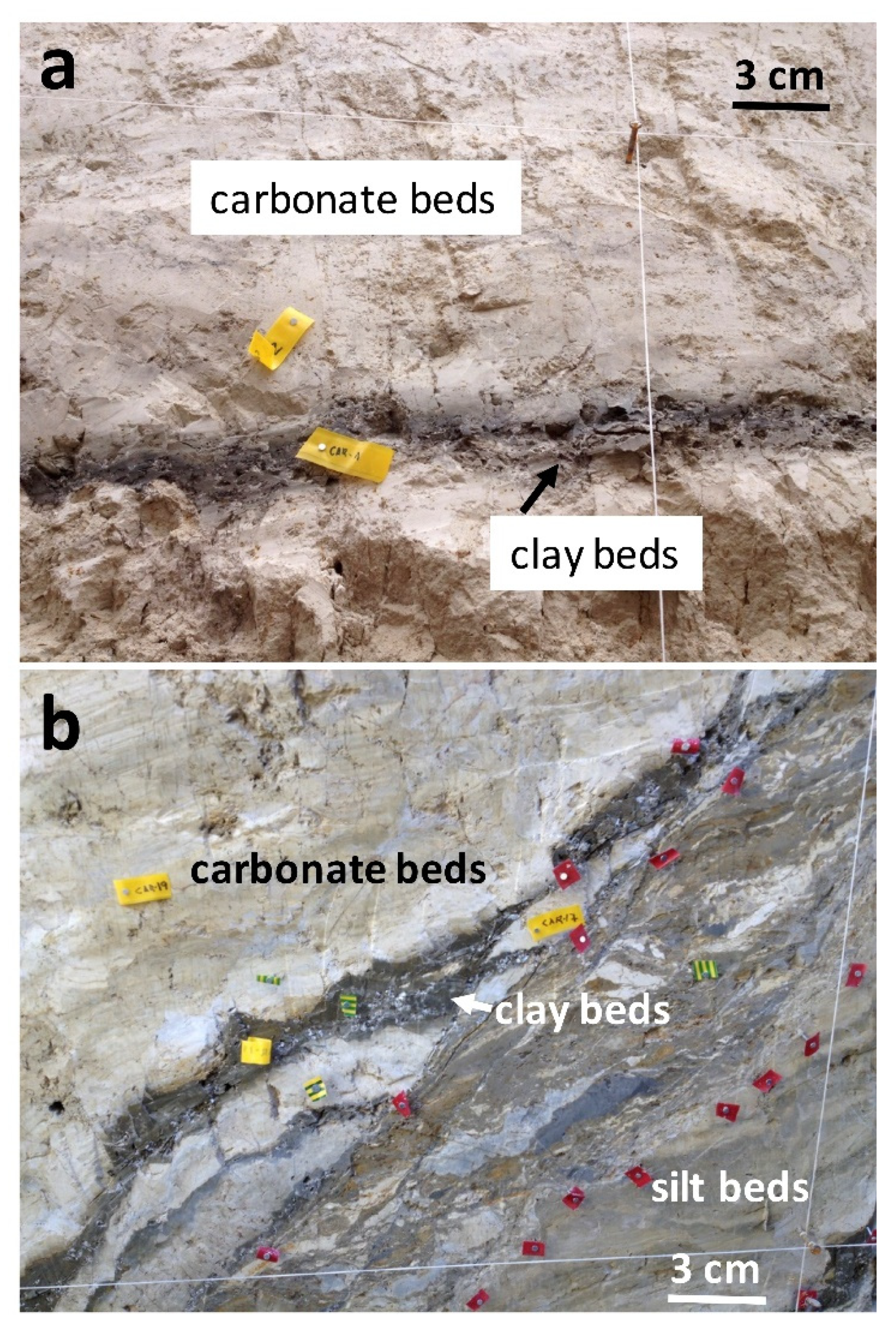
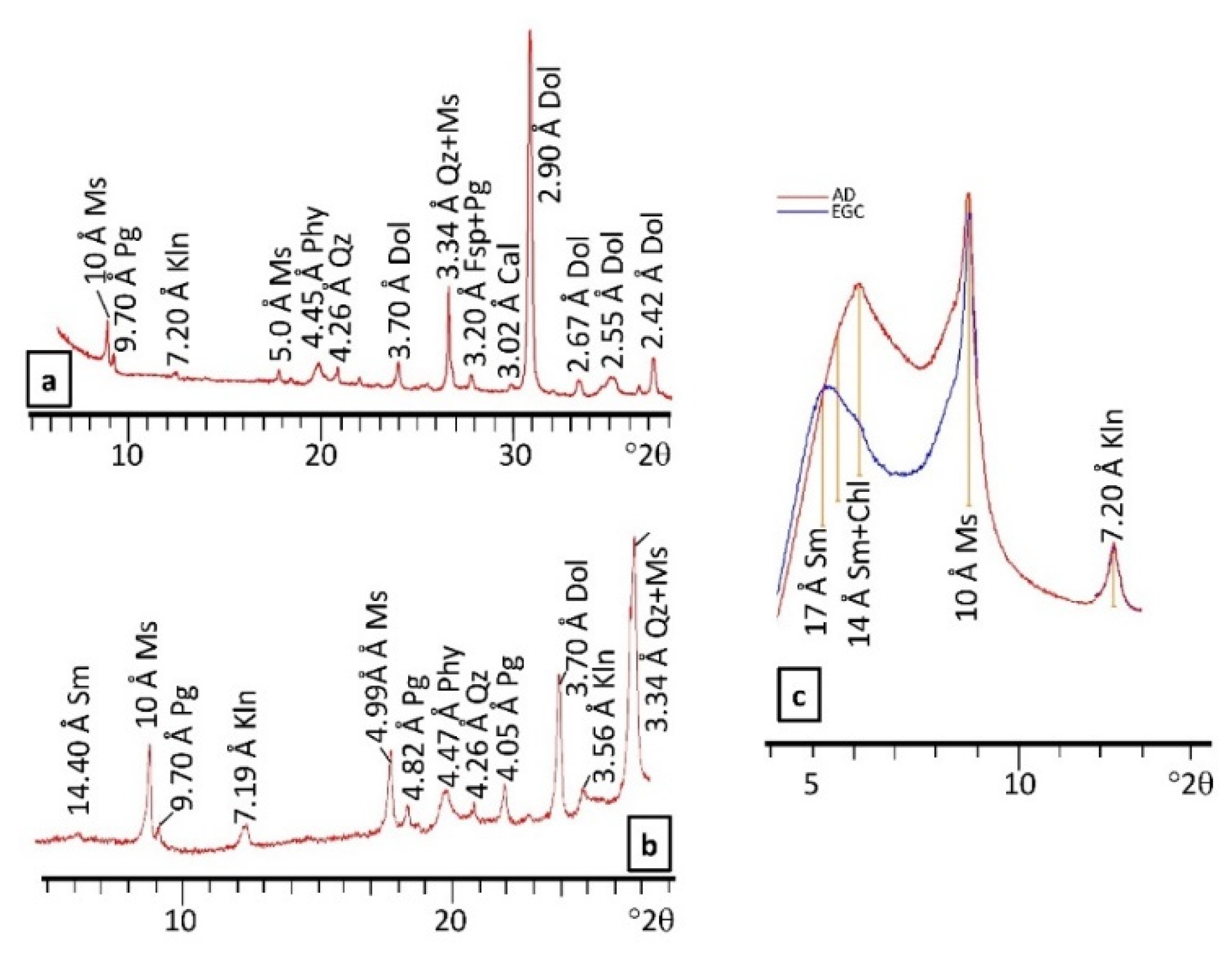

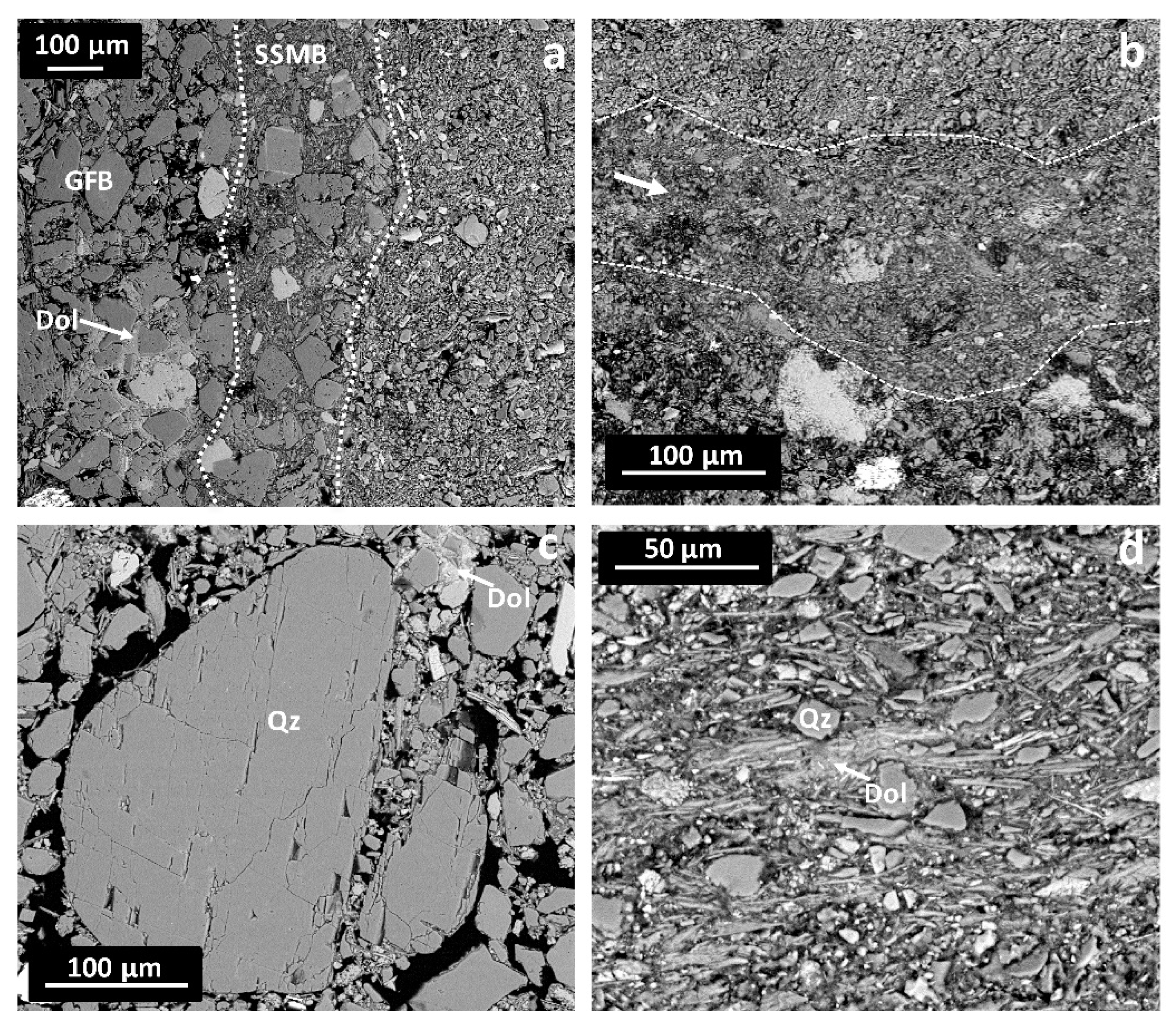
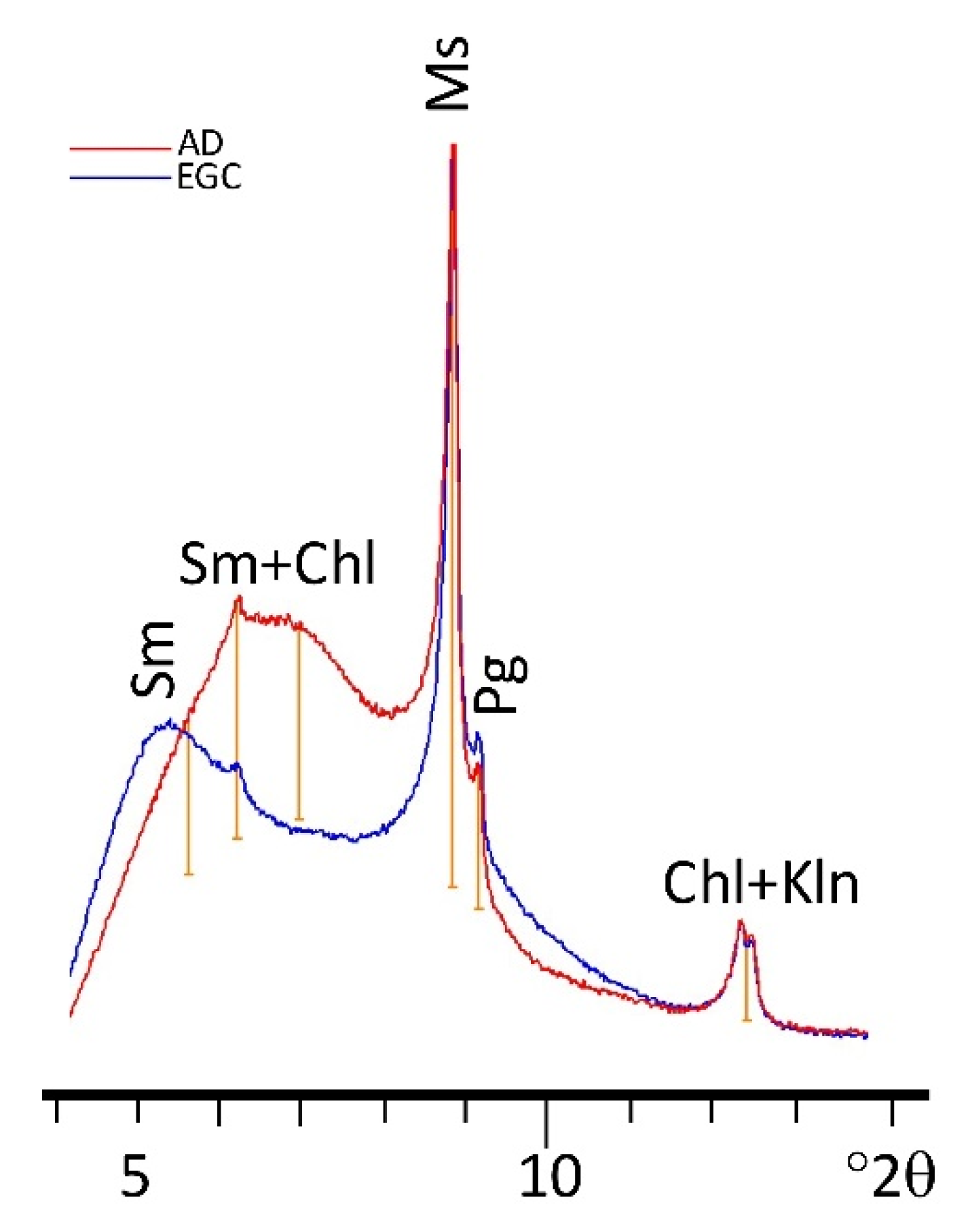
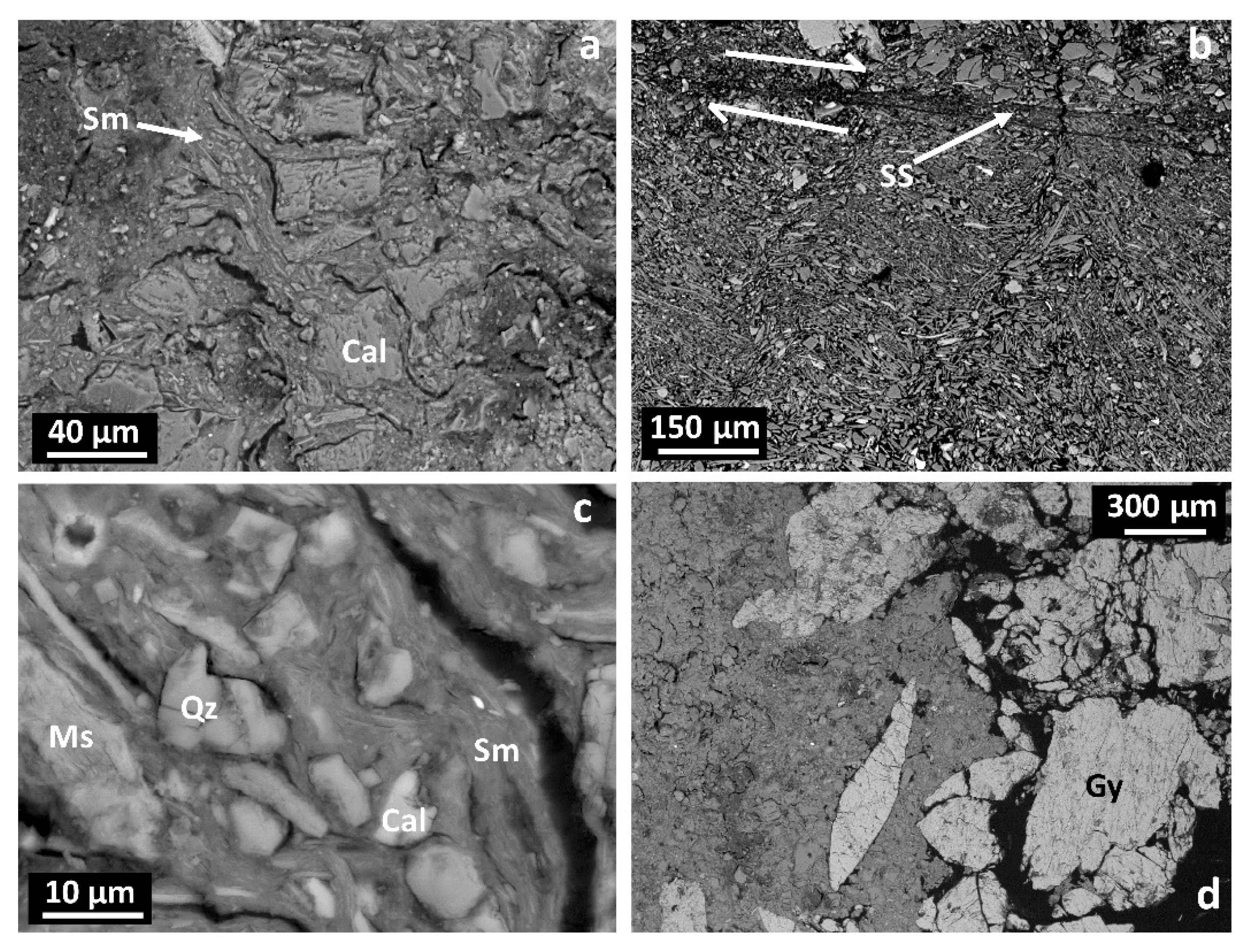
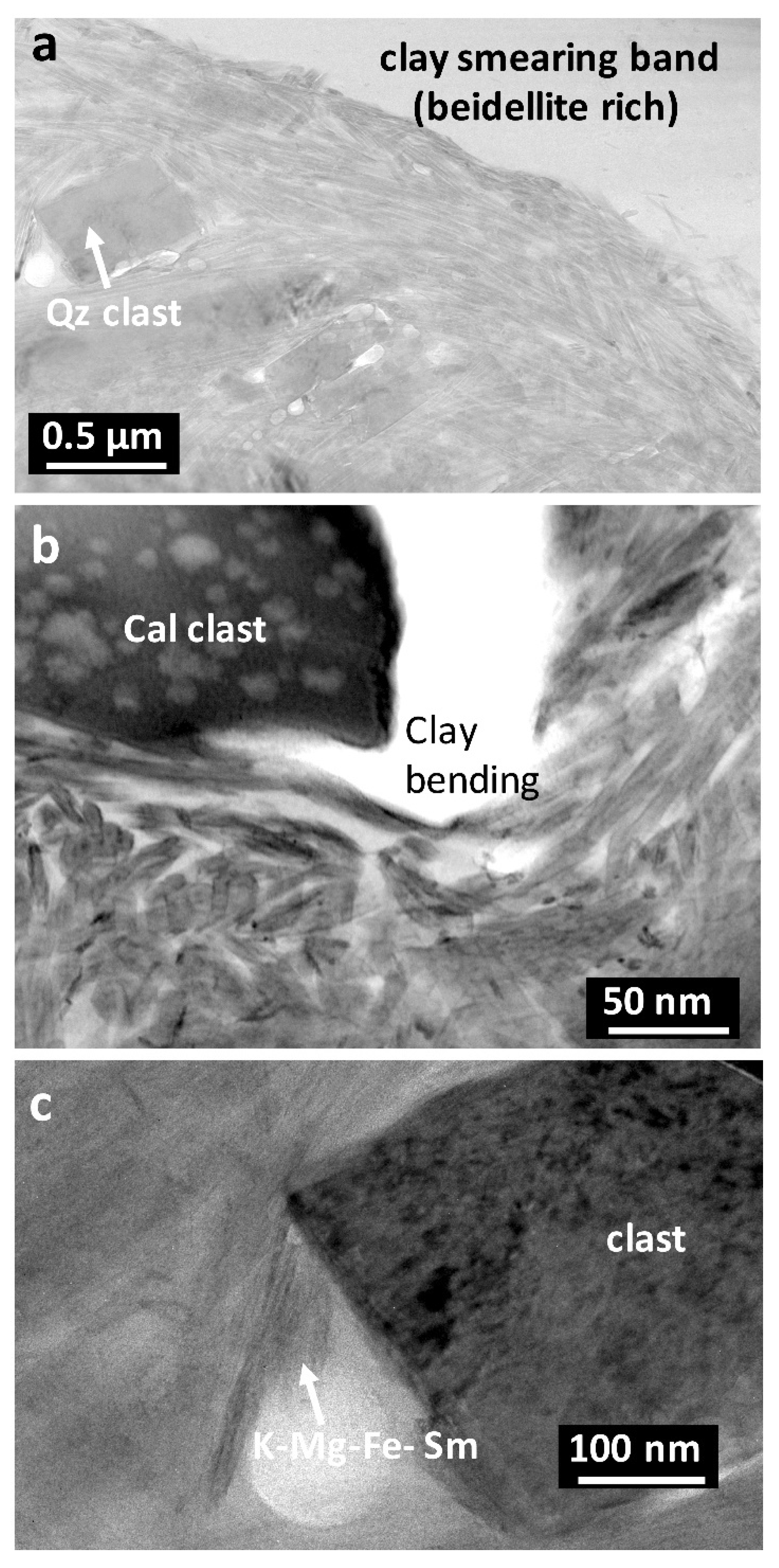
| Si | Al IV | Al VI | Fe | Mg | Mn | Ti | ∑ VI | O.C. * | Ca | K | Na | ∑ XII | |
|---|---|---|---|---|---|---|---|---|---|---|---|---|---|
| a. Smectite in carbonate beds | |||||||||||||
| 1 | 3.67 | 0.33 | 1.91 | 0.06 | 0.07 | 0.00 | 0.00 | 2.04 | 0.05 | 0.09 | 0.06 | 0.02 | 0.17 |
| 2 | 3.71 | 0.29 | 1.89 | 0.06 | 0.08 | 0.00 | 0.00 | 2.03 | 0.01 | 0.10 | 0.05 | 0.01 | 0.16 |
| 3 | 3.75 | 0.25 | 1.86 | 0.08 | 0.10 | 0.00 | 0.00 | 2.04 | 0.02 | 0.11 | 0.06 | 0.02 | 0.19 |
| b. Smectite in smearing bands | |||||||||||||
| 4 | 3.80 | 0.20 | 1.84 | 0.11 | 0.09 | 0.00 | 0.00 | 2.04 | 0.03 | 0.04 | 0.09 | 0.01 | 0.14 |
| 5 | 3.70 | 0.30 | 1.88 | 0.08 | 0.09 | 0.00 | 0.00 | 2.05 | 0.06 | 0.07 | 0.07 | 0.02 | 0.16 |
| 6 | 3.66 | 0.34 | 1.90 | 0.07 | 0.08 | 0.00 | 0.00 | 2.05 | 0.07 | 0.06 | 0.08 | 0.02 | 0.16 |
| 7 | 3.73 | 0.27 | 1.87 | 0.08 | 0.11 | 0.00 | 0.00 | 2.06 | 0.07 | 0.04 | 0.08 | 0.02 | 0.14 |
| 8 | 3.78 | 0.22 | 1.87 | 0.08 | 0.10 | 0.00 | 0.00 | 2.05 | 0.05 | 0.04 | 0.09 | 0.02 | 0.15 |
| 9 | 3.66 | 0.34 | 1.83 | 0.13 | 0.09 | 0.00 | 0.00 | 2.05 | 0.06 | 0.07 | 0.11 | 0.03 | 0.21 |
| c. Smectite in pressure shadows | |||||||||||||
| 10 | 3.74 | 0.26 | 1.05 | 0.57 | 0.52 | 0.00 | 0.00 | 2.14 | −0.15 | 0.04 | 0.55 | 0.12 | 0.71 |
| 11 | 3.64 | 0.36 | 1.01 | 0.54 | 0.58 | 0.00 | 0.00 | 2.13 | −0.15 | 0.01 | 0.62 | 0.11 | 0.74 |
| 12 | 3.73 | 0.23 | 1.13 | 0.52 | 0.48 | 0.00 | 0.00 | 2.13 | −0.13 | 0.02 | 0.45 | 0.15 | 0.62 |
| 13 | 3.69 | 0.31 | 1.06 | 0.55 | 0.52 | 0.00 | 0.00 | 2.13 | −0.16 | 0.03 | 0.46 | 0.15 | 0.64 |
| 14 | 3.64 | 0.36 | 1.20 | 0.41 | 0.50 | 0.00 | 0.00 | 2.11 | −0.08 | 0.04 | 0.41 | 0.18 | 0.63 |
| 15 | 3.64 | 0.36 | 1.03 | 0.54 | 0.57 | 0.00 | 0.00 | 2.14 | −0.12 | 0.01 | 0.46 | 0.14 | 0.61 |
Publisher’s Note: MDPI stays neutral with regard to jurisdictional claims in published maps and institutional affiliations. |
© 2022 by the authors. Licensee MDPI, Basel, Switzerland. This article is an open access article distributed under the terms and conditions of the Creative Commons Attribution (CC BY) license (https://creativecommons.org/licenses/by/4.0/).
Share and Cite
Jiménez-Millán, J.; Abad, I.; García-Tortosa, F.J.; Jiménez-Espinosa, R. Structural Diagenesis in Clay Smearing Bands Developed on Plio-Pleistocene Sediments Affected by the Baza Fault (S Spain). Minerals 2022, 12, 1255. https://doi.org/10.3390/min12101255
Jiménez-Millán J, Abad I, García-Tortosa FJ, Jiménez-Espinosa R. Structural Diagenesis in Clay Smearing Bands Developed on Plio-Pleistocene Sediments Affected by the Baza Fault (S Spain). Minerals. 2022; 12(10):1255. https://doi.org/10.3390/min12101255
Chicago/Turabian StyleJiménez-Millán, Juan, Isabel Abad, Francisco Juan García-Tortosa, and Rosario Jiménez-Espinosa. 2022. "Structural Diagenesis in Clay Smearing Bands Developed on Plio-Pleistocene Sediments Affected by the Baza Fault (S Spain)" Minerals 12, no. 10: 1255. https://doi.org/10.3390/min12101255
APA StyleJiménez-Millán, J., Abad, I., García-Tortosa, F. J., & Jiménez-Espinosa, R. (2022). Structural Diagenesis in Clay Smearing Bands Developed on Plio-Pleistocene Sediments Affected by the Baza Fault (S Spain). Minerals, 12(10), 1255. https://doi.org/10.3390/min12101255






